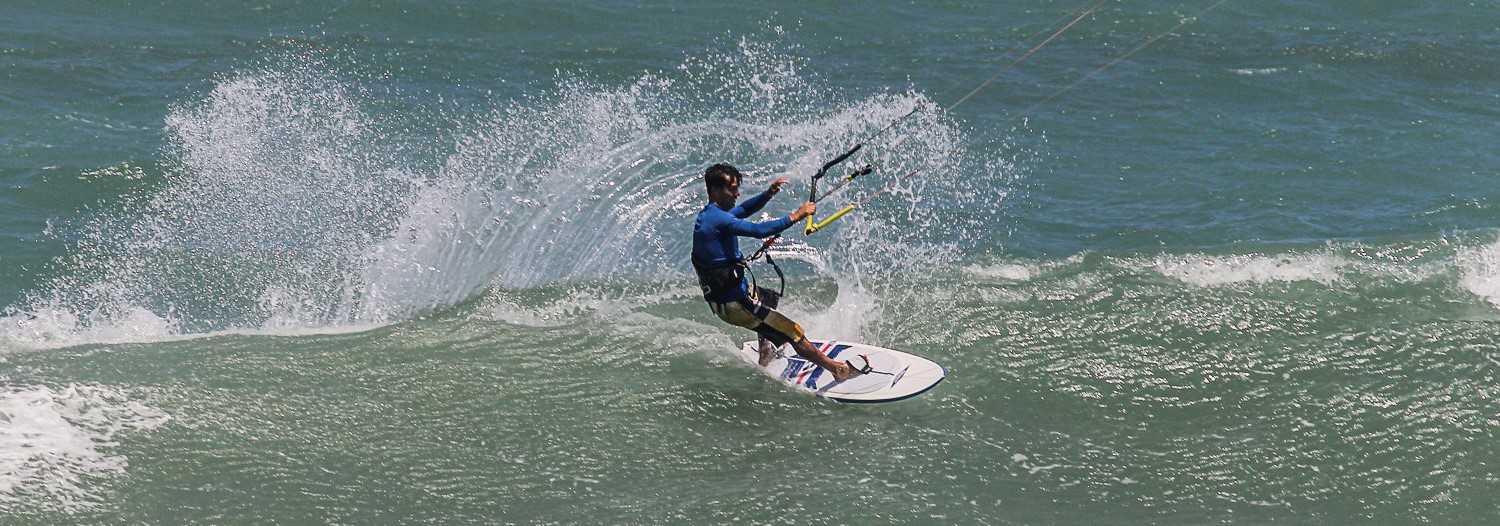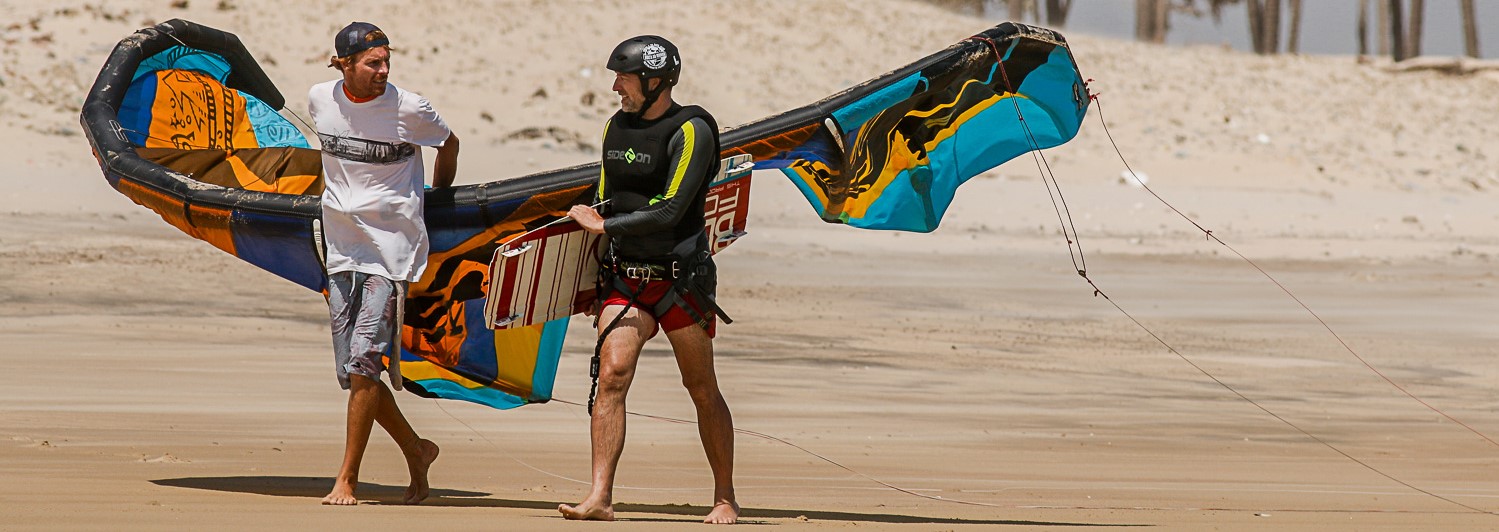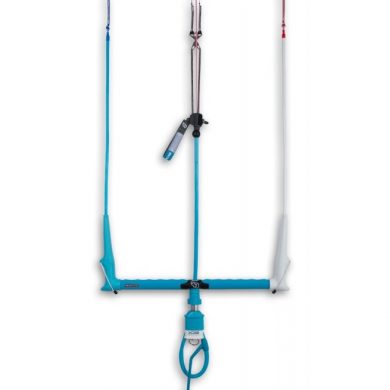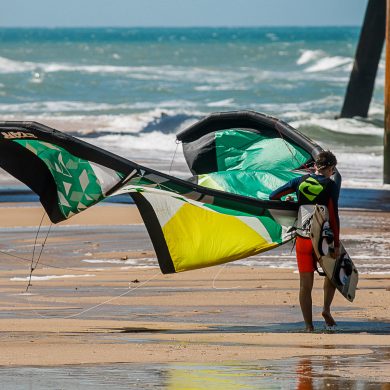
Born from the union of a kite and a surfboard to enjoy the best of the sky and the sea, kitesurfing is a water sport with growing success over recent years.
Accessible from the early age of 12, kitesurfing is a very popular water sport in Brazil that requires a relatively short learning period, between 8h and 15h for most beginners. This makes it interesting for travelers who come to discover the regions of the world perfect for its practice, in particular for visitors of Nordeste, Brazil.
This page is tailored especially for people who wish to learn more about the sport but also for those existing riders who plan to travel to the Nordeste of Brazil and experience the mecca for themselves. Here, we give you our small overview of “planet kitesurf.”
With this additional information, we aim to inform you well enough, so that on the occasion of your trip to Brazil, you can confidently take the plunge and go on a journey of kitesurfing and discovery of a relatively uncrowded and spectacular region.

ALL YOU NEED TO KNOW ABOUT KITESURFING

A BRIEF HISTORY OF KITESURFING
Kitesurfing is a young sport based on an inflatable kite sail invented in 1984 by the French brothers from Quimper, Dominique & Bruno Legaignoux. However, its popularity is mainly due to “Manu” Bertin,” a windsurfing champion who would promote it from 1995, when he appeared at the helm of a kite on the cover of Voile and Sailing ship magazines.
Also known as airborne boarding and kiteboarding, international kiteboarding is managed by both the International Kiteboarding association (IKA) and the Global kitesports association (GKA). Both these organisations work alongside World Sailing which is the governing body for all sailing sports worldwide to ensure the development of the sport, this includes organising international and national competitions covering all the different styles of riding.

KITESURF EQUIPMENT
The equipment needed for kitesurfing consists of 4 basic elements: the kite, the lines, the control bar and harness and finally the board. Here is a small description of each of them to better understand the gear.
 The Kite
The Kite
At the crossroads between a kite, a paraglider and windsurfing sails, the kite surf kite is the “engine” that provides the traction needed to get out of the water and move. The characteristics of these are chosen according to 4 main parameters: the force of the wind, the weight of the practitioner, their level and the type of practice envisaged. The sizes are between 3 and 20 m² but for adults it is most often between 8 and 12 m².
There are 2 main types of kitesurf kites:
The first category consists of inflatable kites, these kites have a section stiffened by inflation which acts as a float allowing it to take off from the water and ensuring its profile in the form of an arch with or without a rigid bar. These is by far the most commonly used kites.
In this category there are two sub-categories: “bow kites” which have an arc shape and which are the most widespread and “C” kites which are of older design but still have their “aficionados”. Both categories also require a pump to inflate the sail.
The other type are called “foil kites”. These are characterized by a flexible profile comparable to paragliders and good kite traction. They have cells along their leading edge which allow air to flow into them. More common for terrestrial practices, there are models of closed cell kites that can be used on the water as well.
 The lines and the kitesurf bar
The lines and the kitesurf bar
The lines consist of thin cables made of a very strong synthetic material, called Dyneema.
There are generally 4 in number.
Two front lines used to transmit the traction power of the kite and the 2 rear lines used for steering and speed management.
Some kites also have a fifth line to facilitate aerial tricks. These are connected to the center of the bar for the first and to the ends of it if there is a second.
The bar is itself is connected to the harness by means of a hook to transmit the traction of the kite. A safety system makes it possible to initially cancel the traction and if necessary to release the kite in case of a problem.
 Kitesurf boards
Kitesurf boards
Kitesurf boards are divided into 2 main categories: surf (like a surfboard with the option of “straps”) and bidirectional boards, called “twin tips“.
These are the easiest to use. Symmetric in design, they can navigate in both directions.
The uni – directional boards are asymmetrical and often take on the appearance of a surfboard, the main difficulty of their use comes from the need to change foot position depending if you are riding on port or starboard. There are different sizes and shapes depending on the intended use (speed, waves, long distances).
The latest kitesurf board is the foil board. In addition to the advantage of being able to ride in little wind, it allows the rider to reach speeds unequaled by wind propulsion on the water. But beware of the falls, at these speeds, the water feels like a solid wall!
 Kitesurf harness
Kitesurf harness
The kitesurfing harness is a crucial piece of Kite surf equipment. It serves as the link between the kite and the body of the practitioner by transmitting the energy needed to get out of the water and move forward.
There are 2 types of kitesurf harness:
The seat harness that distributes pressure on the waist, lower back and upper thighs like a climbing harness. It is ideal for beginners because it distributes forces better and will be more comfortable for long distances.
The waist harness is mainly based on the lower back and pelvis, lighter and less restrictive, it allows greater freedom of movement, which makes it ideal for the practice of Freestyle where riders practice jumps and rotations.

KITESURF, AN ACCESSIBLE GLIDE SPORT!
Learning to kitesurf only requires good physical condition and a minimum size, making it accessible from about 12 years of age. With modern equipment, a little patience and a good instructor, it can be learnt very easily. The basic learning is done in 7 to 8 hours for the most talented, i.e. 4 to 5 days at a rate of 2 hours per day. And with a little more practice, it is very achievable for those who experience more difficulties.
In this regard, we strongly recommend that you take lessons with professional instructors before you start practicing this sport. You should beware that many natives quickly improvise kitesurfing lessons, taking advantage of the growing success of the discipline of recent years. It is therefore at your own risk, and the risk of your early progress in the sport that you engage with them to learn, perhaps in a bid to take advantage of often cheaper rates. If you want to avoid this pitfall, seek the services of an IKO (International kite Association) certified teacher or school who will be able to share with you their knowledge in the best conditions.
However, beware of unreasonable prices, there is no regulation in the matter and even if your teacher is certified by IKO, offers good equipment and is teaching with a walkie-talkie (the most effective method once you’re in the aquatic phase), it is advisable to compare prices a little to avoid being taken advantage of. To be sure of having the best quality / price ratio for your course and not spoil your holidays with inadequate teaching, we can organize a special initiation stay adapted to your needs, contact us for more information.
STEPS IN KITESURF LEARNING
The process of learning to Kitesurf can be described in four main stages. During each one of them, the student discovers a particular aspect of the sport which requires synchronization between 2 elements, the air and the water. Step by step, they become familiar with the equipment and their interaction with the elements becomes second nature.
PART 1: ON LAND – CONTROLLING THE KITE
You will begin with a phase of about 4 to 5 hours during which you will learn the theoretical basics of the practice of kitesurfing. After exploring the various parts of the equipment and digesting the points on safety, you will be placed into action for the first time, and learn how to handle the kite on the beach.
During this phase you will practice how to lift your kite, how to land it and how to use the wind to your advantage.
PART 2: ON WATER, YOUR FIRST MANEUVERS
The second stage is known as the “body drag” phase. This is where you learn to maneuver your kite in the sea but without your board. You’ll discover how to handle the pulling effect and steer the kite to where you want it.
During this phase you will be able to experience the first sensations of gliding, pulled by the kite and begin to learn the management of the space including the sharing of the sky with other practitioners.
PART 3: YOUR BOARD AT YOUR FEET
This is the last part of the basics before you really get started. It consists of getting on the board, moored to your kite, and finally enjoying the thrill of sliding on water drawn by your airborne sail.
During this final phase of learning the basics of kite surfing you will learn how to get out of the water and to slide but also to change direction and steer the board in different ways to manage the traction of your kite.
PART 4: RIDER IN ALL DIRECTIONS
To be able to fully navigate in all directions, you will finally have to tackle a last critical phase which consists of knowing how to go upwind, otherwise you will drift back to your starting point and end up back on the beach!
Once you have mastered this technical aspect you will be ready to start to approach the fifth stage, that of jumps and tricks, an area where the possibilities are infinite and learning never stops!

KITESURF EQUIPMENT, A CONSTANT EVOLUTION FOR IMPROVED EFFICIENCY
Since the beginning of the 2000s when kitesurfing first appeared, the material has evolved considerably in terms of safety and maneuverability and the practice has become all the easier.
Good schools rent great equipment and this can be a good option for those who want to travel light. If you are sure you want to learn and practice this exciting sport, the other option is to buy your equipment. A twin tip board, a harness, a kite and a helm and you are ready to go. Learning to kite with a surfboard normally comes later. About $2000 or £1500 covers the budget. Note that we often need at least 2 kites, overuse can lead to wear and tear.
A last option for the gear would be for it to be provided to you on the spot, indeed “kitesurfmania” has encouraged some manufacturers to come and install production units in the popular practice areas. In the Northeast of Brazil in particular, it has not been done yet but even if the projects take a long time to come to fruition, it seems like this is on the cards. A good option to look out for!

KITESURF IN BRAZIL, A COUNTRY IN THE WIND!
The Brazilian coastline of 7491 km offers thousands of beaches that delight vacationers and locals. Adored by surfers, the Nordeste coast offers an impressive range of heavenly places with small authentic villages where locals welcome you warmly and the uncrowded beaches allow quiet stays, and beautiful waves.
In recent years, Brazil and its enchanting spots has attracted a new population of board riders, the Kitesurfers. With ideal conditions during the middle of the year, kitesurfing in Brazil has earned its nobility and has become over time a lifestyle for locals and foreigners from all walks of life who settle in the Nordeste.
With their 4X4 and other buggies, they crisscross the hundreds of miles of virtually uninhabited coastline looking for new spots and ideal conditions for all types of practices. Among this community are many American and European people who have fallen in love with the region with its lagoons and endless beaches with tumultuous waves.
Permanently living here, they now offer charming pousadas such as in Paracuru (URL=/kitesurfing-fortaleza) where they have also set up kite learning and development schools all along the coast. During a trip to Brazil, one can thus afford courses in exceptional conditions for much cheaper than America and without the problem of the language barrier. An opportunity not to be missed!
Brazil has also produced some of the biggest names in the world of Kitesurfing, including Set Texeira representing the men, and for the women Bruna Kajiya and the 14 year – old, multi world champion kitesurfing prodigy Mikaili Sol.
For all these reasons a kite surfing trip to Brazil is a real moment of splendour, allowing you to combine the pleasure of discovery, beautiful wild landscapes, an authentic culture and the practice of this sport amongst the best conditions in the world.

THE NORDESTE, BRAZIL, AN IDEAL REGION TO PRACTICE KITESURF IN SAFETY!
Kitesurfing is a very attractive sport and relatively easy to learn, it can sometimes however, be dangerous if we do not respect the safety instructions. Most accidents occur on bodies of water where space is reduced and collisions are more frequent because of the high density of riders.
The ideal situation for riding is to have room to leave a margin for error. The immense beaches of Northeast Brazil, little frequented as soon as you get away from the most famous ones, allow you to keep your distance on the water as well as on the beach where the maneuvers of taking off and landing your kite are the most delicate. There is nowhere better to learn, to progress quickly or simply to make you feel happy and alive among all the serenity! In the Nordeste of Brazil, you have vast spaces to kite without constraints!
With this in mind, Frédéric, creator of Brazil Selection and kitesurfer for more than 12 years has designed a special downwind trip in the Nordeste. Combining downwind and stops in the most beautiful lagoons of the coast of Ceara with a break every day in a small coastal village, this circuit is aimed rather at experienced kitesurfers who wish to combine the pleasure of kiting and discovery of the region in the best conditions . For beginners and travelers wishing to learn about Brazil, we can also create “à la carte” packages that allow you to discover the beauties of the region while taking classes during strategic breaks in the spots most suitable for the group’s ability.
With the help of a 4X4 and its driver who follows you along the coast, you can choose to kite whenever and wherever you want. Entirely modifiable according to your desires, this tour will allow you to discover among others the spots of Cumbuco, Paracuru or Guajiru, Icaraizinho and Préa //kitesurfing-jericoacoara. Contact us to find out more! This is an ideal way to fully enjoy the various conditions and settings on offer in the region.

 The Kite
The Kite The lines and the kitesurf bar
The lines and the kitesurf bar Kitesurf boards
Kitesurf boards Kitesurf harness
Kitesurf harness







